Eldritch Horror is a mysterious and exciting cooperative board game for 2-8 players, where each player is given the role of an investigator working to stop the Ancient One from covering the world in a blanket of darkness, chaos, and dismay.
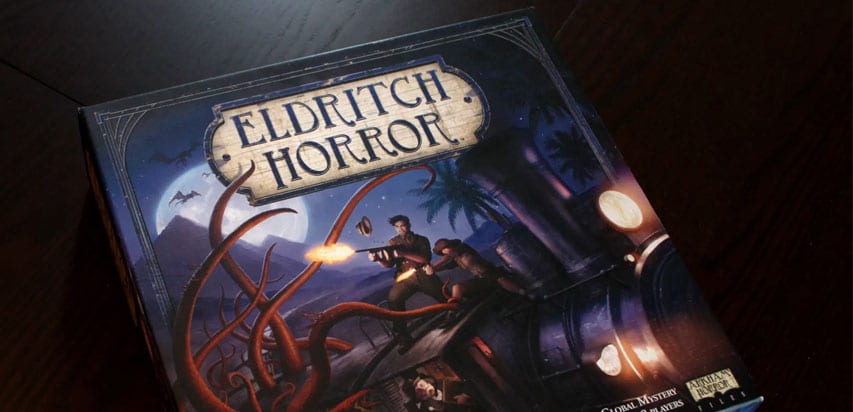
Players will have to face a series of complicated mysteries, challenges, and threats, which in turn earn them useful trinkets and spells that they may later use to defeat the Ancient One and its army of monsters.
Winning (or Losing) the Game
There are several ways to win (or lose) a game
If you and your teammates solve 3 mysteries before the Ancient One is awakened, then you win the game. However, if the Doom token manages to reach the “Zero” space on your Doom tracker, the Ancient One is spawned and you’ll have to deal with the consequences listed on the back of the Ancient One’s card.
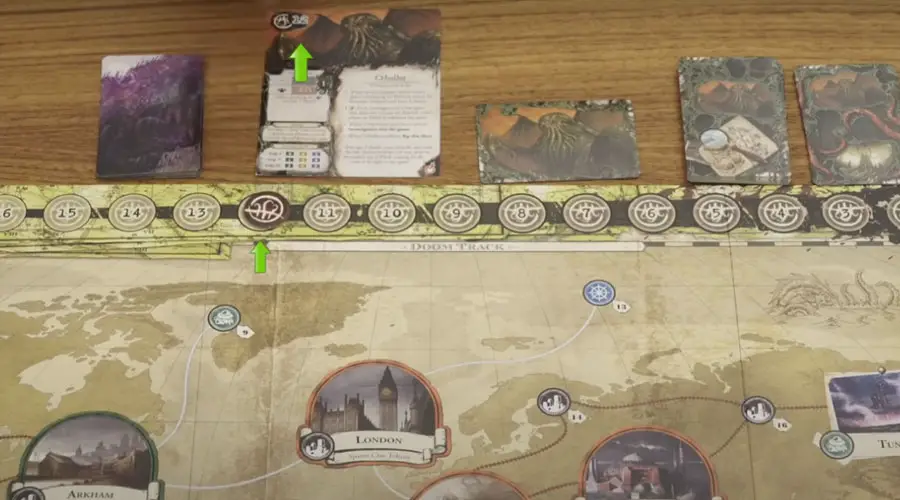
Most Ancient Ones have a “Final Mystery” for you to solve. Do this, and you and your team win the game and the Ancient One goes back into its dark, miserable hole. If, however, you can’t solve the Ancient One’s final mystery, then your team loses, and you all fall insane or crippled.
Investigator Overview
Each player controls one investigator who possesses different levels of:
- Health
- Sanity
- Stats (5 stats each)
- 2 special abilities (1 passive and 1 usable as an action)
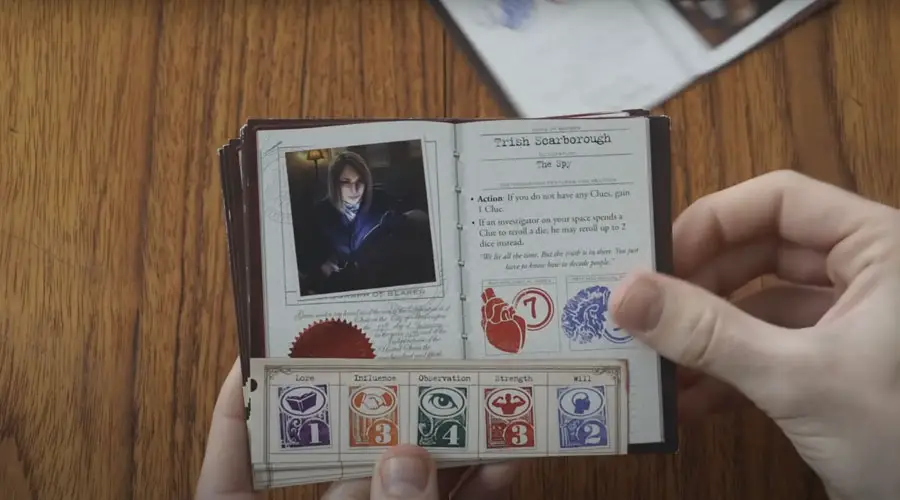
Eldritch Horror includes 24 investigators, each with unique skills that you can use to defeat the Ancient One and its minions.
The Three Game Phases
The game is played in a course of rounds and within each round, there are three phases:
- Action Phase
- Encounter Phase
- Mythos Phase
Action Phase
During the action phase, each player can perform 1 or 2 actions, but they can’t perform the same action more than once.

There are 6 actions that you can perform, which are:
- Travel
- Prepare for Travel
- Rest
- Trade
- Acquire Assets
- Component Actions
Travel
This allows you to move your investigator to any adjacent location from your starting point. If you have travel tickets, you can also spend them to move additional spaces.

There are two types of travel tickets: Train Tickets (which allow you to move through train paths) and Ship Tickets (which allow you to move through Ocean Paths). One ticket is equivalent to one space, but you can spend multiple tickets at a time (if you have them).

Prepare for Travel
Travel Tickets are earned through the Prepare for Travel action. If you’re in a city space, you can use an action to gain 1 Travel Ticket of your choice. However, there must be a Train Path or an Ocean Path adjacent to the city to get those respective tickets. If you have more than 2 adjacent paths, you must choose 2 to keep and discard the others.
Rest
This action allows you to regain 1 Health and 1 Sanity, but only up to the maximum amount for your investigator. This action can also trigger several card effects, so you better watch out before you decide to Rest.

Trade
If you and another investigator are in the same location, you can choose to Trade items with each other.
This includes:
- assets
- artifacts
- clues
- spells
- travel tickets
Acquire Assets
Another great way to get items is through the Acquire Assets action. If you’re in a city space that doesn’t contain any monsters, you may attempt to acquire assets from the Reserve by performing an Influence Test. You can do this by rolling a number of dice equal to your Influence Skill ± any modifiers.

Component Actions
Component Actions are basically the actions that are listed on cards and investigator sheets. You can’t perform the actions of a single component twice in one turn, but you can, however, perform component actions of two different components.

Once every player has performed their actions, the encounter phase begins.
Encounter Phase
Starting with the lead investigator, each investigator chooses a type of encounter to have.
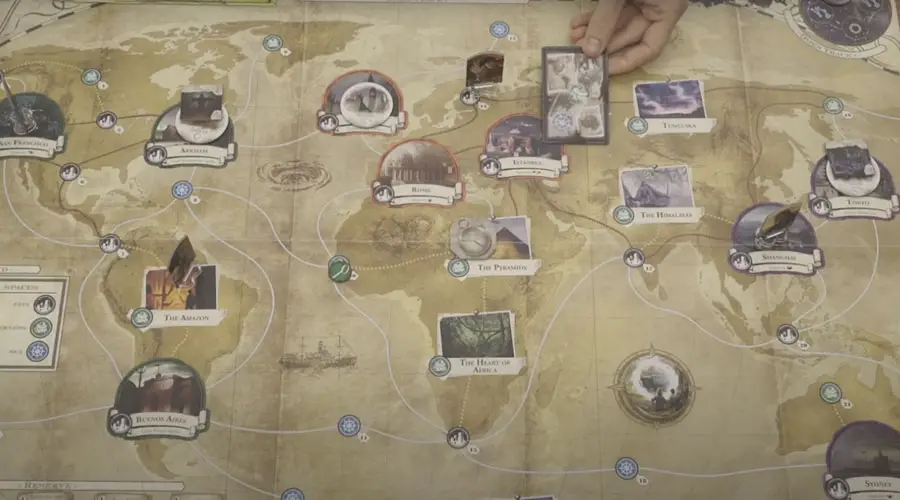
These encounters will either require you to fight Monsters or solve mysteries (on Mystery cards) in your current space.
General Encounters
If your investigator is in the middle of nowhere, you can draw a general encounter to resolve the effect that matches your investigator’s space.
The encounter will show a symbol, which refers to one of your skills, and might show a positive or negative number. You call this number a “modifier” which tells you if you can add or subtract any dice to your roll (skill test).

General encounters are complex and random, so you never know whether you’ll get a positive or negative effect from this encounter. If you want more controlled encounters, try going to main cities and completing their encounters.
Location and Token Encounters
Effects from Location Encounters tend to be easier to determine because they’re listed on the location itself on the board. When you perform a location encounter, you draw one card that matches the space that your investigator is currently on and complete the skill tests that are listed on the back.

Token encounters function the same way as location encounters, in the sense that every time there’s a token on the board that affects you, that’s a token encounter.

If there’s a Clue in your location, you can perform a Research Encounter. To use a Clue, draw a card from the Research Encounter deck specific to the Ancient One you’re currently using. Clues allow you to re-roll dice during tests, but they’re often spent as part of certain mysteries or other effects.
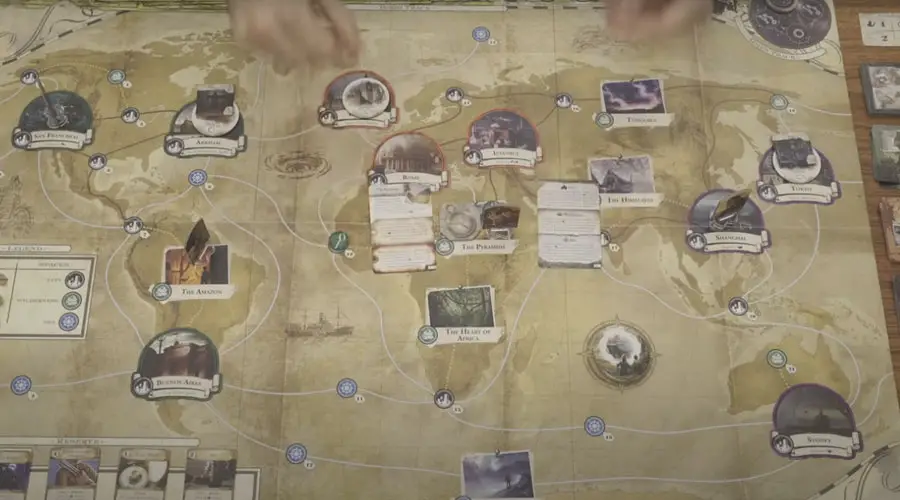
Now, if you’re on a space with a Gate, you can draw an Other World-Encounter card, which may or may not help you close the gate.
If you’re feeling adventurous, you can use the Active Expedition Token, which lets you perform one Complex Expedition Encounter.
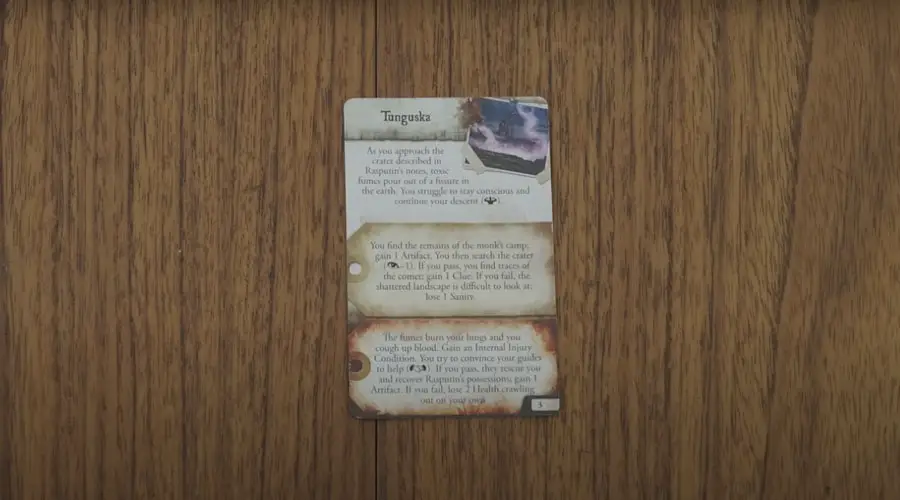
In Complex Encounters, whether you win or fail the first encounter, you must move on to the next encounter. If you win, solve the middle encounter. If you lose, solve the one written last.
At the end of an Expedition Encounter, move the Expedition Token to the location that matches the top card on the Expedition Deck.
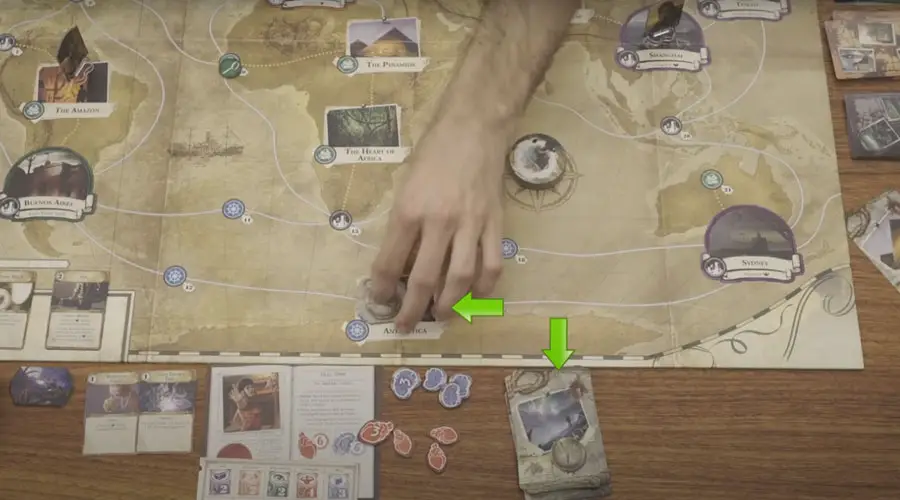
There are also 2 types of token encounters that don’t involve playing cards: Rumor Tokens and Defeated Investigators.

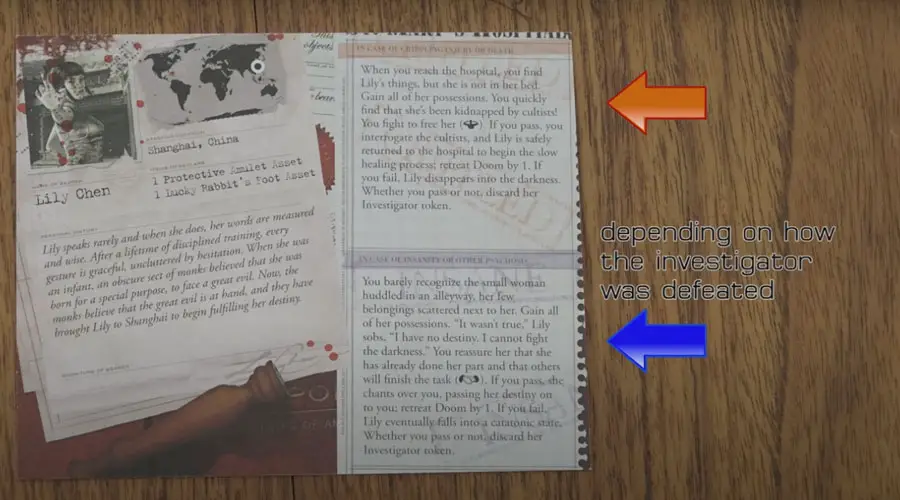
Combat Encounters
On the back of each monster token are conditions for two tests: Will Test and Strength Test. These tests may include positive or negative modifiers that can change your fate in the game.

The number of successes needed in a Will Test is equal to how horrifying the monster you’re facing is. If you meet or exceed that, then nothing happens, and you can proceed to the strength test. If you’re defeated, however, you’ll lose sanity equal to the difference.
During the Strength Test, each success reduces the monster’s toughness by “1.”
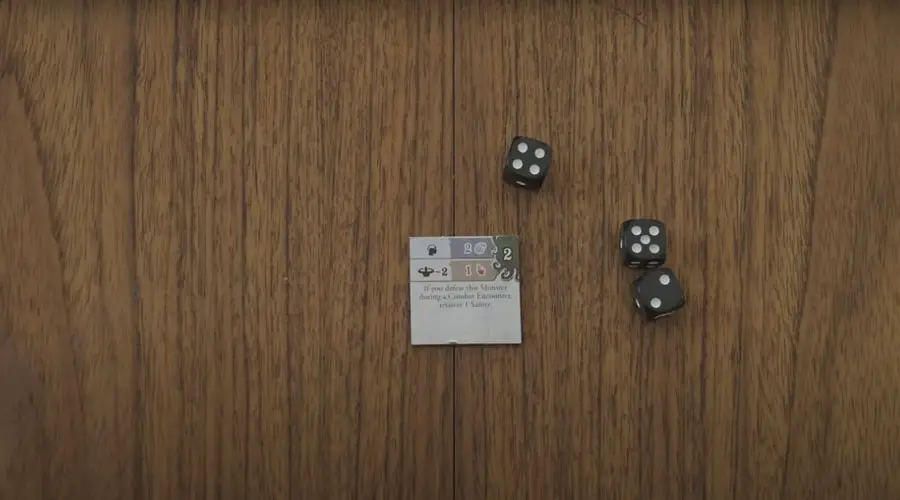
Items and spells help a lot during this part of the encounter phase, so it’s not a bad idea to stock up on those.
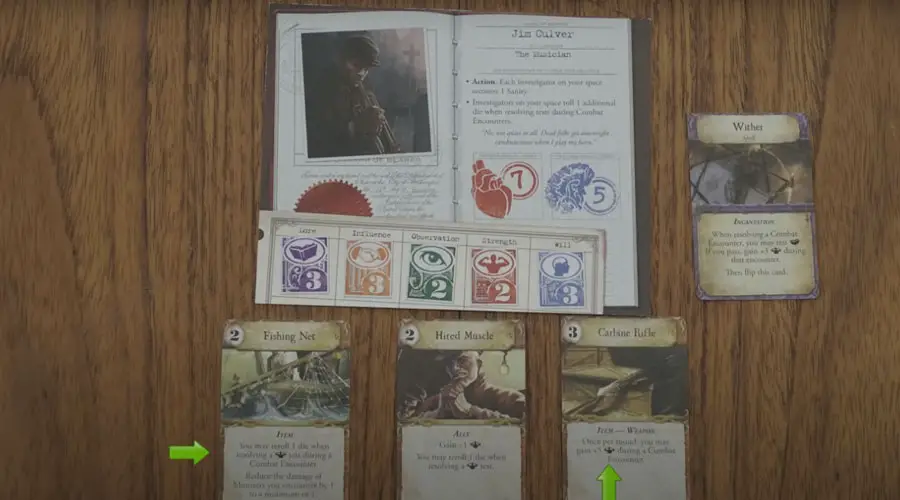
However, you can use the abilities from all your other cards on top of your bonuses. Any ability that specifically instructs you to roll an extra die is also used. (These aren’t considered bonuses and are therefore counted separately.)
If you manage to kill ALL monsters in your space, you’re allowed to perform one more encounter on your turn.
Now, there may be times when effects cause monsters to ambush you. If this happens, draw the monster from your monster cup and have a Combat Encounter with it to discard it.
Let’s Talk About Monsters
During combat encounters, there are two types of monsters that you’ll have to face: Normal and Epic monsters.
There are two ways to defeat a Normal Monster: When the monster loses Health equal or greater than its toughness OR when it’s affected directly by an effect in the game. After a normal monster is defeated, you return the monster token back into the monster cup to play in another round.
Epic Monsters can only be defeated one way: When it loses Health equal to its toughness. Once an epic monster is defeated, you return the monster token back into the box.
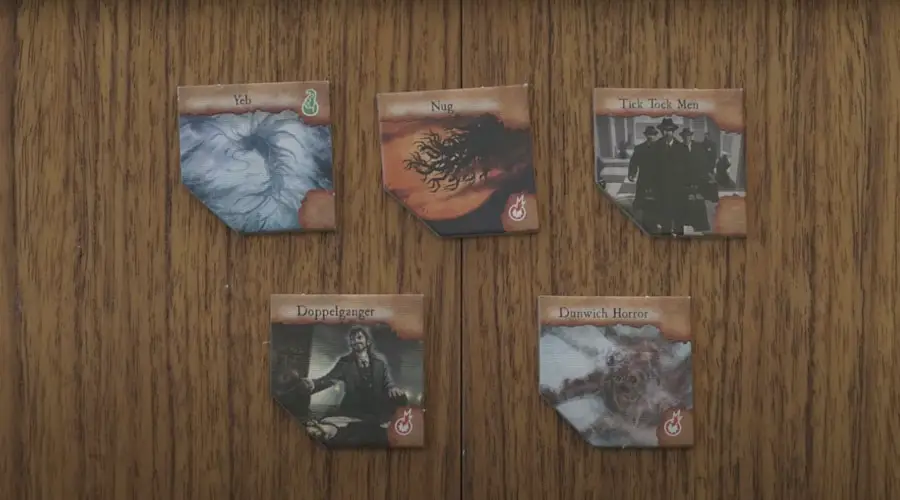
Defeated and Devoured Investigators
If your investigator loses all their Health and Sanity tokens, they become crippled, insane, or defeated. When this happens, you must advance the Doom Token one step and move your defeated investigator to the nearest city and place a health or sanity token on it to show what you’ve lost.
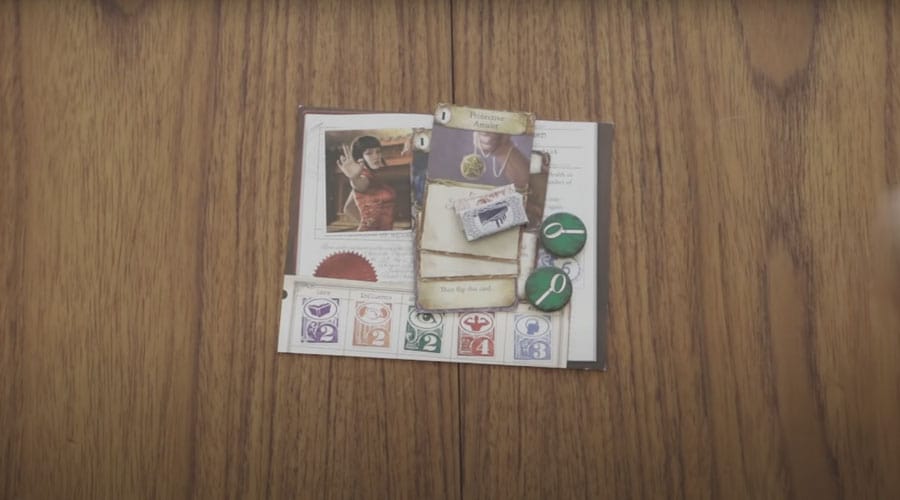
Lastly, discard all your conditions, health, sanity, and improvement tokens, placing them on top of your investigator sheet.
At the end of the turn, you will be given the chance to choose a new investigator, and you’ll continue playing with their starting possessions and location. If you were the Lead Investigator, pass the first-player token to the next player to assume control.
Some effects cause investigators to be devoured by their enemies. When this happens, treat it like they were defeated, but nothing is left of the original investigator, including their items.
Once every player has performed an encounter, you can all move on to the Mythos Phase.
Mythos Phase
At the end of every turn, the Lead Investigator (the first-player) will draw the top card from the Mythos deck and resolve its effects.
There are three types of cards:
- Yellow
- Green
- Blue

All of which contain effects that may advance the Doom token, spawn more Gates, or raise new challenges for investigators to overcome.
Yellow Cards (Omen Cards) always advance the Omen Track, moving the Omen Token one step clockwise and advancing the Doom tracker by one. This will then trigger a Reckoning Effect.


Reckoning Effects can trigger any of the following (in order):
- Monsters
- The Ancient One
- Ongoing Mythos Cards
- Investigator Possessions and Conditions
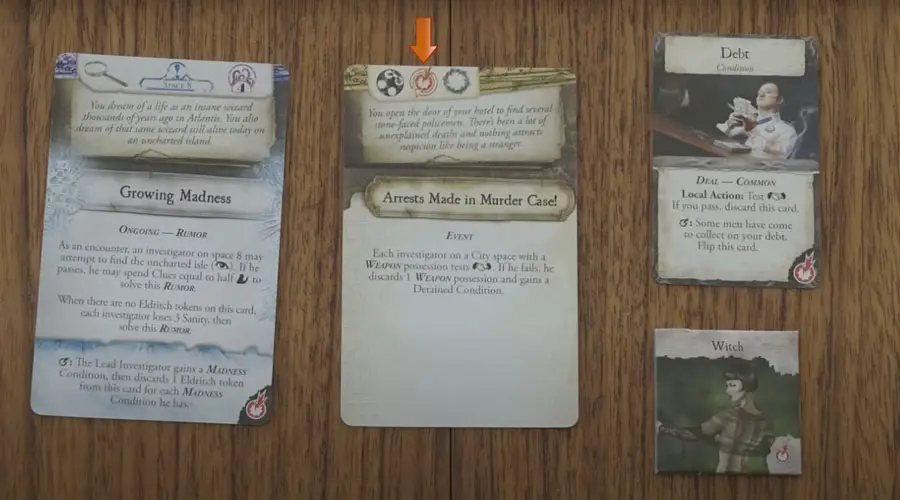
Green Cards also advance the Omen Track but cause a monster surge on top of the initial misfortune, spawning random monsters depending on the number of players located on every gate that matches the Omen.
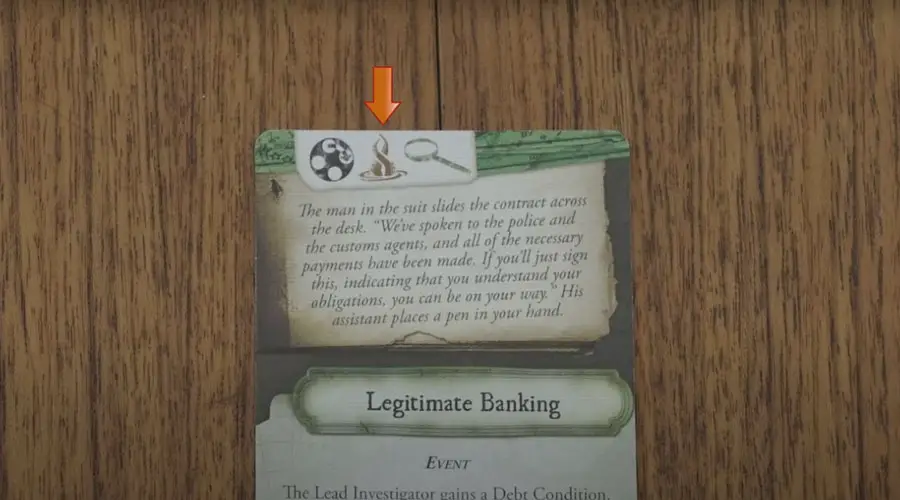
Green Cards can also spawn Clues. Depending on the number of players, draw Clue Tokens from the Token Pool and place them in appropriate locations on the map.
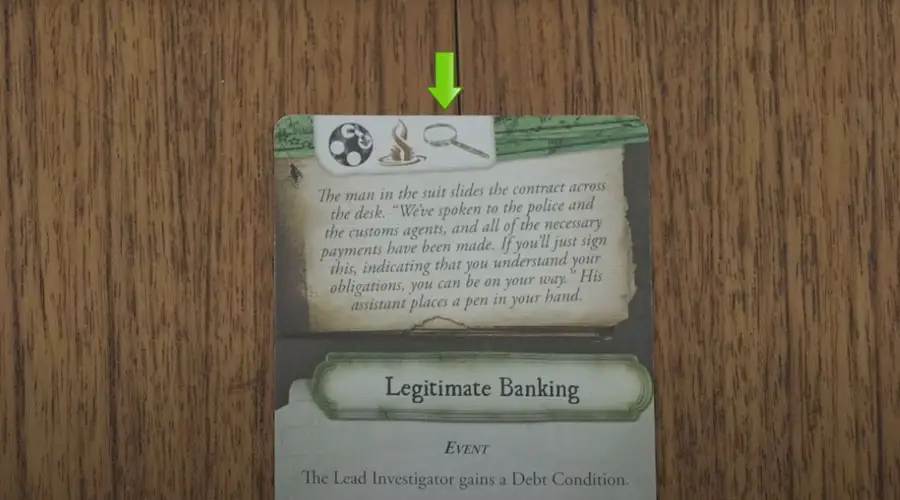
Blue Mythos cards may also spawn Clues, but can also start a Rumor. Rumors usually create special encounters that need to be completed before a certain number of Reckonings happen, or else investigators must suffer great consequences.
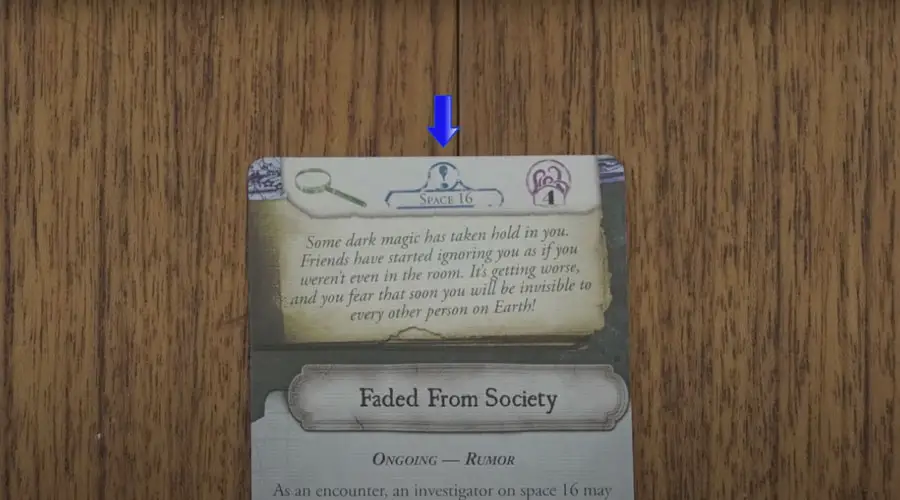
Once the Mythos Phase is complete and you’ve solved the first mystery, draw the next mystery card from the deck and place it next to the Ancient One. Choose another player to be the next Lead Investigator and start the next Action Phase.
Again, If you manage to solve 3 mysteries before the Ancient One awakens, the endgame is triggered, and you and your team have won the game. However, you lose the game if you run out of Mythos Cards before you solve all mysteries related to your chosen Ancient One.
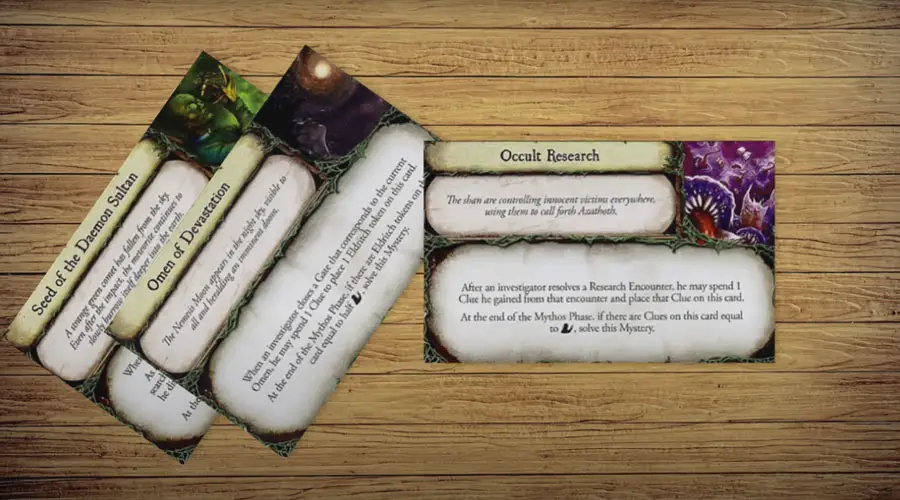
If the Doom Tracker reaches “Zero,” the Ancient One awakens. Some Ancient Ones end the game in a loss, but others trigger an end-game sequence requiring you to finish a difficult Final Mystery to win the game.
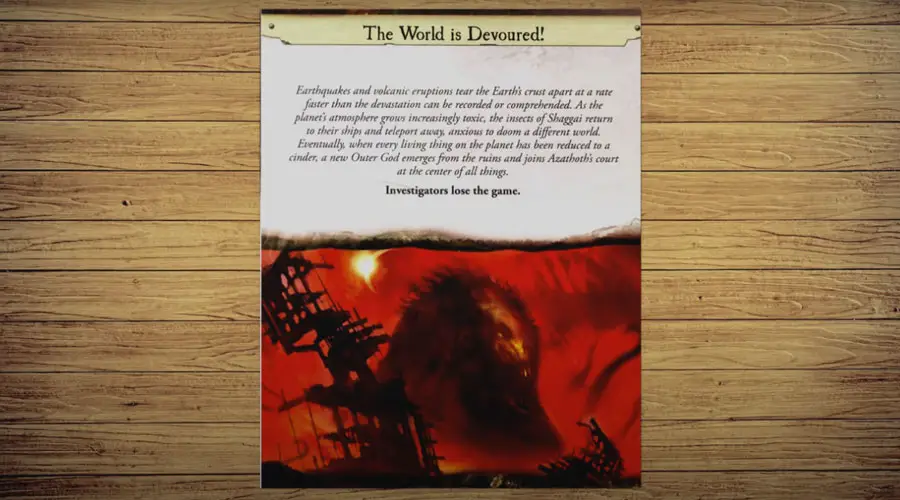
Setting Up the Game
Step 1
To start the game, lay out the game board on a flat surface where everyone has equal access to it.
Arrange all the tokens, separating the Gate and Clue tokens into face-down stacks. Then create a general token pool by collecting all Health, Improvement, Eldritch, Rumor, Mystery, Sanity, and Travel Ticket tokens and placing them in a pile within easy reach of all players.

Step 2
Choose your antagonist.
There are 4 Ancient Ones to choose from:
- Cthulhu
- Azathoth
- Yog-Sothoth
- Shub-Niggurath
Each of these monsters has its own corresponding deck of mysteries and research encounters, so make sure to separate the ones you aren’t using once you settle for a character.
Step 3
Place the Doom tracker on the listed number and the Omen tracker on the green comet. Perform any extra setup instruction listed on your Ancient One card.
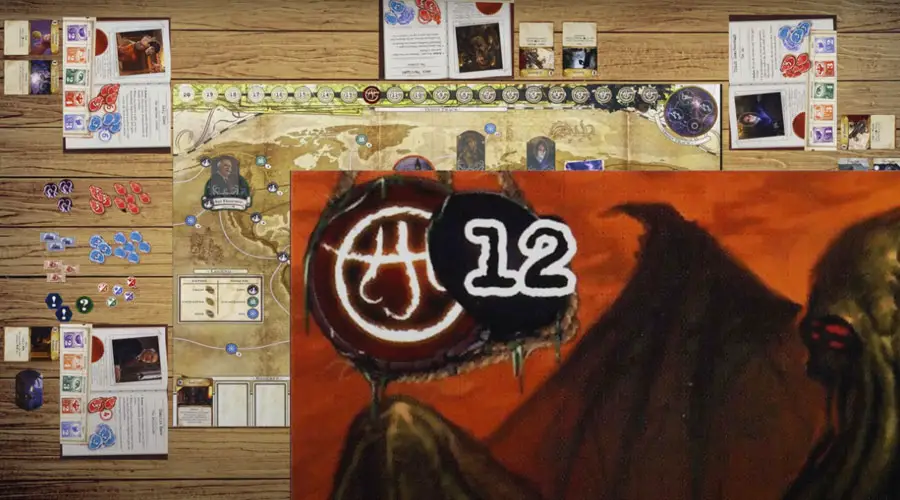
Step 4
Now, it’s time to choose your investigator. You’ll notice that each investigator offers different levels of skills from the other, so when you’re choosing, make sure you pick the one that will help you out the most in-game.

Step 5
Once you’ve chosen your investigator, you’ll start off with a few items, which are listed on the back portion of your investigator card.
Search through the asset and spell decks to collect your starting possessions. Next, collect health and sanity tokens from the general token pool.

After all that is sorted out, place your character stand on your starting location, which is also listed on the back portion of your investigator card.

You’ll also have to choose one player to be the first player. Give this player the first player token.
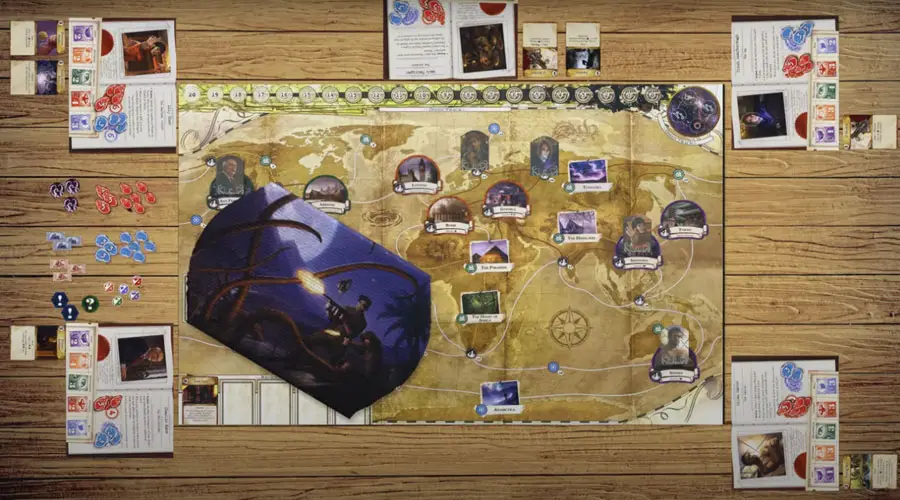
Step 6
Next, you’re going to build the Mythos deck. These are cards of events that come up after each turn that — more often than not — cause players dangerous and costly consequences during their turn.
Making the Mythos deck is simple. Check the back part of your Ancient One card and at the bottom left corner, you’ll see a table that shows 3 sets of 3 numbers all colored green, yellow, and blue. Use this as a basis to create 3 Mythos decks for stages 1, 2, and 3 of the game.

Shuffle each deck individually and place them in numerical order with the Stage 1 deck on top.
Step 7
Collect the rest of the cards and place them in easy to reach areas around the table.
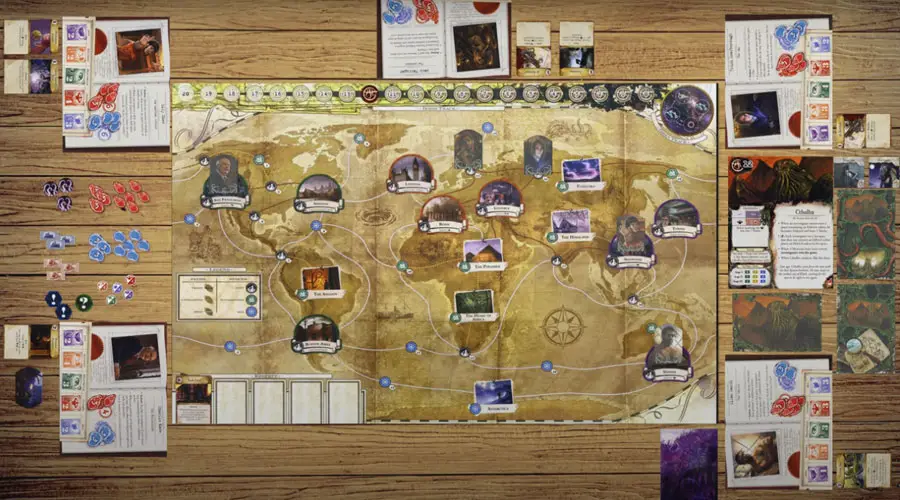
Next, separate all the Normal Monsters from the Epic Monsters., placing all Normal Monsters in an opaque container. This container will be your Monster Cup.
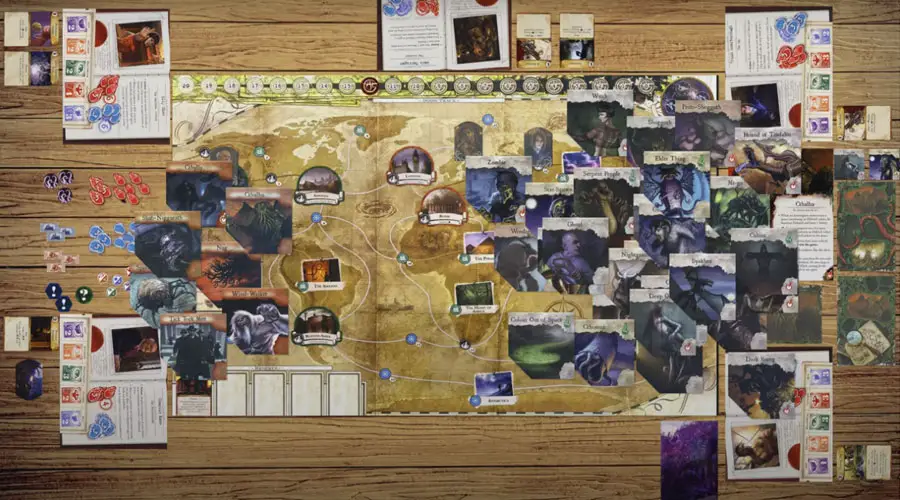
Step 8
In this next step, you’ll have to resolve starting effects. Take the appropriate Reference Card for the number of players in the game. The Reference Card will tell you how many Gates and Clues to start with.
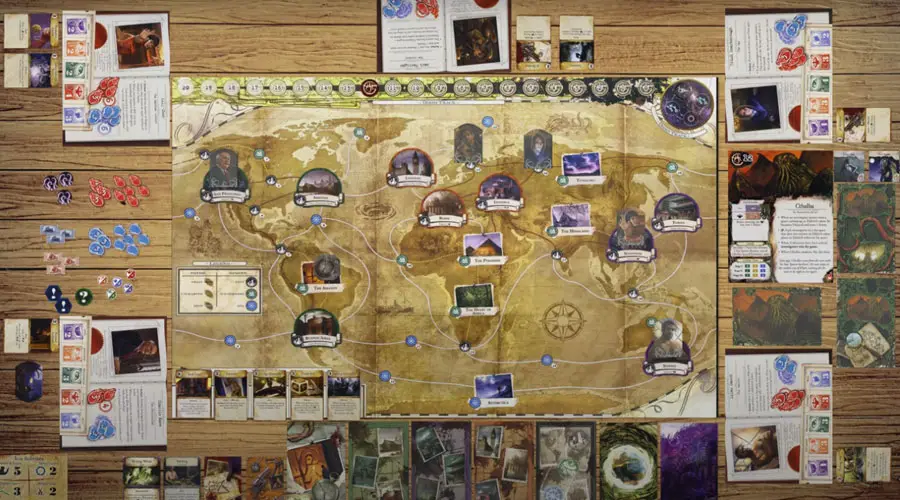
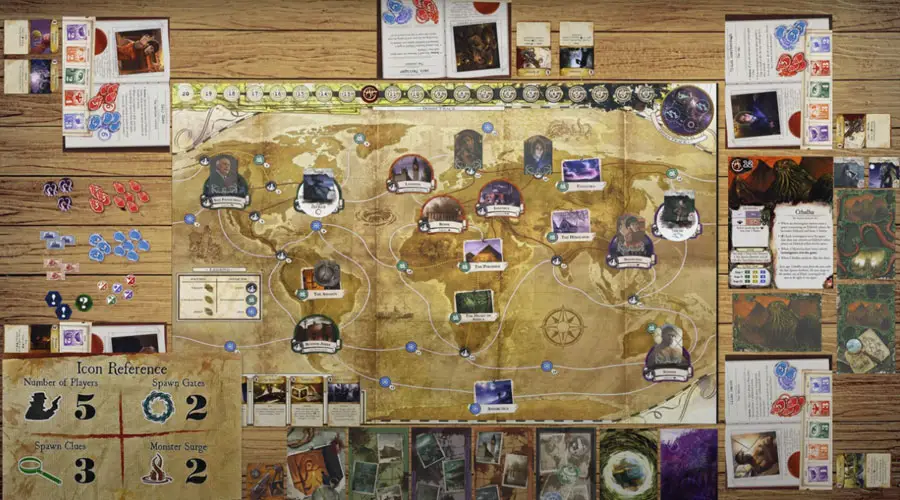
Step 9
Finally, you’ll also need to draw some Asset Cards for the Reserve. Place them on the “Reserve” corner of the game board.
Put the Mystery Token on the location shown on the top card of the Expedition deck. Now, draw the first mystery card and place it near the Ancient One.
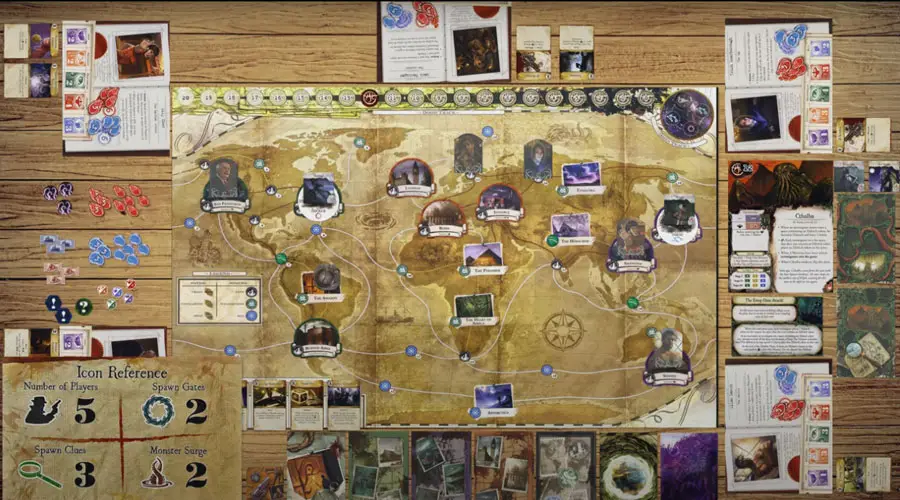
Once all this is set up, you’ll be ready to play Eldritch Horror!
If you want to add more excitement to the basic Eldritch Horror game, there are dozens of expansion packs you can try that features brand-new Ancient Ones, Investigators, Monsters, and Mysteries. Check them out online when you find the time.
